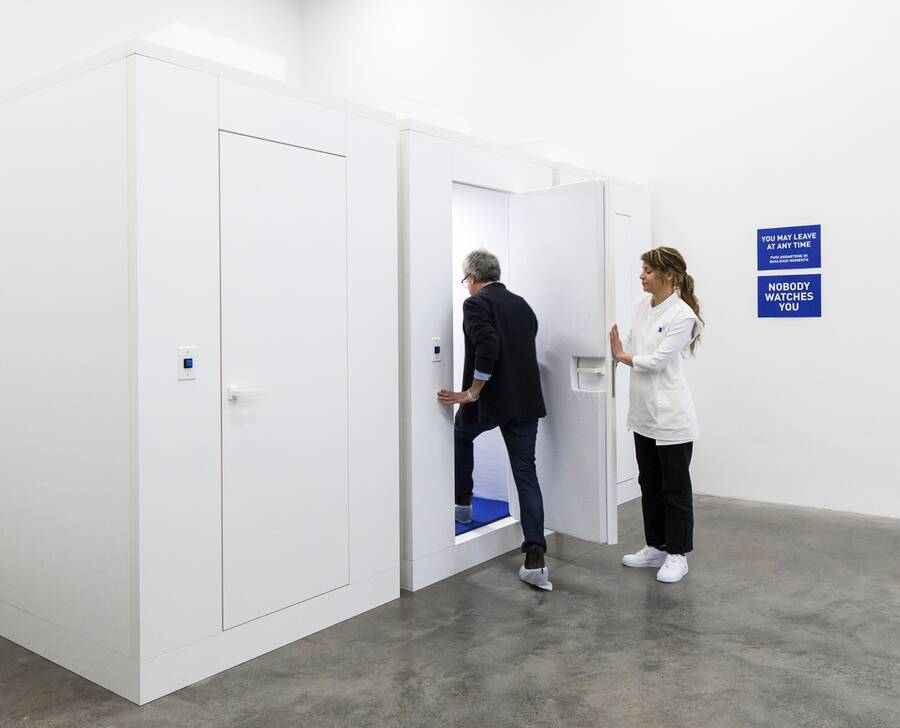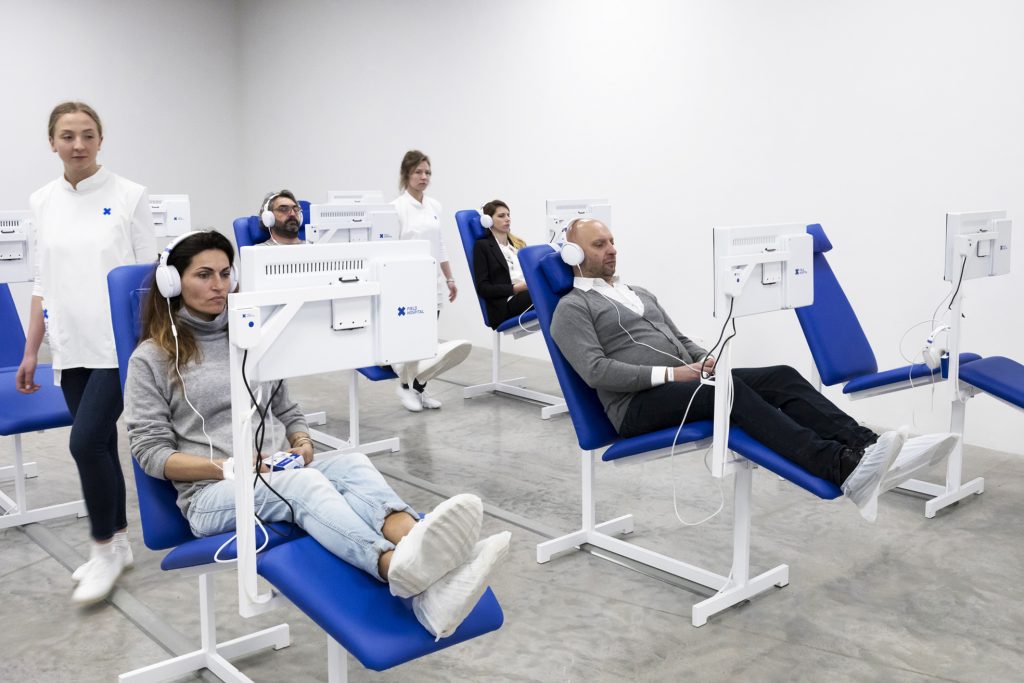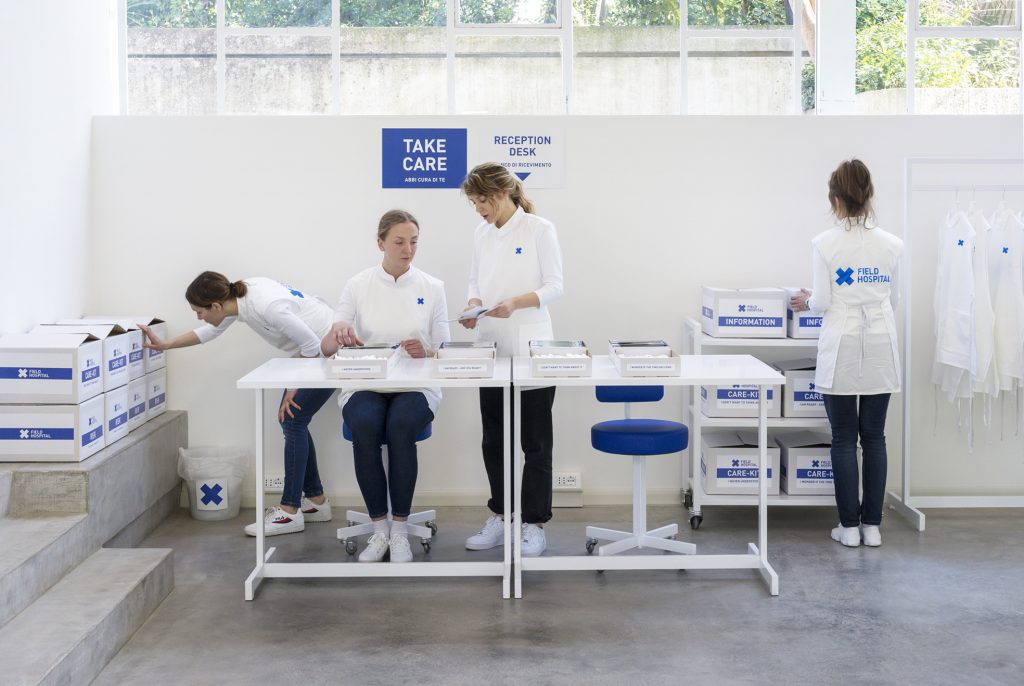Here Anyone Can Live Free
The Israeli Pavilion at the Venice Biennale raises uncomfortable questions about who should make social practice art.

EVERY TWO YEARS, scores of art tourists wearing summer scarves and couture sunglasses arrive at the Venice Bienniale. Possibly the world’s classiest mega event, the international art expo has its origins in a fin-de-siecle art show devised by municipal leaders to draw visitors to Venice.
Just a few years into its history, Bienniale organizers started to group presenting artists by nationality. Soon afterward, countries began to build their own pavilions, giving the whole thing the feel of a world’s fair. The narrow pathways of the Giradini, a waterfront park where much of the Bienniale is held, proffer a who’s who of 20th-century nationalism: Hungary’s grand Jugendstil house conjures the last days of Habsburgian opulence; America’s brickwork Monticello knockoff betrays our 1920s provincialism; and the clean-lined modernism of Venezuela’s 1956 pavilion is a sad memory of oil-rich times. Somewhat fittingly, Israel’s pavilion backs directly onto the US’s. Its compact white mass conceals a three-story interior; designed in 1952 by Zeev Rechter, it provides a nice contrast to the US pavilion’s Neo-Palladian frumpiness.
Each country that participates in the Bienniale exhibits the work of one living artist or collective in its pavilion. (Many other artists are featured in a central show area.) In some countries, like France, the government convenes a special body to select an artist; in the US, the task is farmed out to a nonprofit. In Israel, the Ministry of Culture and Sport selects a curator every two years, who in turn selects an artist to fill the country’s pavilion with a site-specific installation or body of work. Past Israeli artists have come almost exclusively from Jewish (and primarily Ashkenazi) backgrounds, although in 1986, the Palestinian Israeli painter Ibrahim Nubani was selected to represent the country. While Palestine furnished its own offsite pavilion for the 2009 Biennale, it has not done so in the years since.
Visitors to the Bienniale have a variety of reasons to steer clear of the Israeli pavilion. For some it’s political, for others it’s pragmatic: in years past, entry required an extra layer of security screening (the only pavilion to do so). This year, though, the doors were wide open, as the artist Aya Ben Ron transformed the Israeli pavilion into a slickly-designed “hospital”—Field Hospital X, as per the piece’s title. Field Hospital X bills itself as “a space in which silenced voices can be heard and social injustices can be seen.” Framing the site as an “institution” in the vein of social practice art emphasizes the community benefit and engagement it will deliver. Such work explores social relationships in a given space, often engaging questions of power, privilege, and community action in ways that have made it a natural medium for artists of color and from the Global South. Secretly, I wondered, are Israelis allowed to make social practice art?
Upon arrival, visitors were asked to take a number and wait in a blue and white terminal until they were called. Parallel rows of chairs facing blaring TVs recalled an airport, flatscreen televisions displayed a woman in blue X-embroidered scrubs calmly issuing instructions to visitors. “You,” she states flatly in subtitled Hebrew, “are entering a safe place.” Unlike the snide, jokey art of nearby pavilions—Belgium presented a demented village scene composed of animatronic puppets—the work’s engagement with themes of care and medical ethics felt uncommonly earnest for the art world. When I spoke with Ben Ron briefly about the “installation,” she corrected me: “It’s a hospital,” she said. And so it was.
When my number finally came up on the board, I headed to a check-in desk where attendants let me select from four “Risk-Wristbands”: I NEVER UNDERSTOOD; I AM READY—ARE YOU READY?; I DON’T WANT TO THINK ABOUT IT; I WONDER IF THE TIME HAS COME.
After making my choice, a tyvek strip with QR code was fastened around my wrist and I proceeded to a staging area where I was instructed to put booties over my shoes. I was pointed toward a soundproof cabin and, once inside, a disembodied voice instructed me in Hebrew-accented English on how to cathartically scream. I was to release a primal scream, once for practice and then twice for real. On exiting, I was led up a flight of stairs to the pavilion’s mezzanine level where 12 people lay back and watched videos on high-tech dentist’s chairs, also in blue and white.
My wristband corresponded to a “Care-Kit,” or a short video; a woman in nurse garb—one of several—scanned the QR code on my wristband to play the video as soon as I lowered myself into one of the reclining chairs. By choosing “I DON’T WANT TO THINK ABOUT IT,” I’d signed up to watch Ben Ron’s work (the three other videos are by artists she selected). In many ways, Field Hospital X is built to house this animated short. Titled No Body, it’s a searing personal testimony about abuse in the artist’s family. The story is told with fairy tale remove from the deck of a sailboat with the motto “ANYONE CAN LIVE HERE FREE” lettered on the side. Ben Ron’s character describes a father who is repeatedly abusive while the rest of the family stays silent. It’s hard to watch and it comes as a relief when, after ten minutes, Ben Ron’s portion comes to an end. A custom remote prompted me to pick from two “second opinions,” one from a Lacanian psychoanalyst and the other from a law professor. Shai Lavi, Professor of Law at Tel Aviv University notes opaquely that, on the one hand, “we don’t know what happens,” to the film’s protagonist, “but we know exactly what happens.”

When you’re done watching your video you summon a “nurse” to your reclining chair so she can cut off your wristband and replace it with a HERE ANYONE CAN LIVE FREE rubberized bracelet, an apparent callback to the yellow Livestrong ones of the mid-aughts. After slipping off my booties I was back out on the crunchy gravel of the Giardini sipping a promotional coffee from Illy.
THE THROWBACK NATIONALISM of the Bienniale is increasingly questioned, both by the presenting artists and the sponsoring institutions. Denmark chose the Palestinian-born artist Larissa Sansour to represent the country because she trained there, but Sansour, who holds a Danish passport, permanently resettled in London a decade ago. Germany was represented by “Natascha Süder Happelmann,” the Deutschified name of Iranian-German artist Natascha Sadr Haghighian, whose work skewers the politics of national identity and the CV-building tricks of international art exhibition culture. In past exhibitions, she has deliberately confounded her own biography, and for the Bienniale she used an online name-generator to create a surname “German enough” for the national pavilion.
While the artists who present work at Venice now steer away from the nationalism baked into the site, the institutional funding and decision-making is firmly stuck within the structure of the state. This can mean a big competitive advantage for artists who hail from smaller, wealthier countries. Israel is small, but it is not nearly as wealthy as the North American and European countries to which it compares itself, and while many artists are critical of the state, they often have to accept some form of support from government-affiliated agencies. When the G.U.L.F. arts advocacy group briefly occupied the Israeli Pavilion in 2015, there was a very public wrestling with what a cultural boycott of Israel might look like and what it might achieve.
Personally, I waffle on the Boycott, Divestment, and Sanctions movement’s call for cultural boycott every couple of months. Is it right to punish cultural workers when the companies that truly fund the most heinous parts of the occupation go unscathed? After all, it’s not the foreign ministry that selects an artist for the Biennale but an independent curator. On the other hand, this curator administers state funds—typically around one million shekels, or $250,000—and currently answers to Culture Minister Miri Regev, a dreaded figure with a past as a military censor. Regev made international news last year when she proposed a chillingly-named Cultural Loyalty Law; though it was later withdrawn, the threat to Israel’s already embattled creative community was clear. “We don’t have the deep pockets that you [Americans] do, we’re a struggling country—always have been,” an Israeli artist told me at an international gathering for Jewish artists I attended last year. “Most artists have, at one point in their careers, received some funding from the state . . . it’s almost impossible not to.”
MY INITIAL PERCEPTION of Ben Ron’s work changed when I returned the following day to watch more of the videos. The four Care-Kits explore injustices that spiral out from intimate themes of gender dysphoria and family abuse to include Israel’s historic mistreatment of Sephardi and Mizrahi Jews and continued persecution of Palestinians. The previous day, I had seen a man in a sheep’s head mask on the screens of my fellow video-watchers. Only when I selected the video—Habit, by an “Anonymous Palestinian”—did I realize that the shot was nearly six minutes of the sheep-man jerking off just outside the frame, stepping forward to spit on the camera lens after blowing his load. The act is raw and disturbing and its inclusion feels both necessary and a bit contrived, a mechanism to rhetorically ask, “Safe spaces for whom?” The author of the video is noncompliant;the program notes that he “refuses to collaborate with the roles assigned to him as a Palestinian person under Israeli occupation,” but he is nonetheless analyzed by an Israeli professor in the “second opinion” which follows the film.
Ben Ron, it seems, is trying to draw out a resonance between domestic and state violence. In her “second opinion” video following No Body, Sagit Alon, the Deputy Director of an Israeli hospital, talks about the act of leaving an abusive family, but I found myself wondering if this was actually a metaphor for an abusive country. Is it an accident that Ben Ron’s character is depicted drifting off on a boat? The viewer is left to make the connection. Unfortunately, by offering up these disparate scenes as parallel options on a menu, Field Hospital X suggests a false equivalency between the personal and the political. The artist’s experience with abuse is, no doubt, harrowing. But it’s not appropriate to place it at the same level as the national traumas of the Palestinian people or the persecution of Mizrahim.
For now, those wishing to experience the hospital will have to pay 25 Euros to see it in the Giardini. There’s some irony to the fact that art elite will be forced to take numbers, queue, and subject themselves to the kind of institutional environment that money and prestige has largely insulated them from. The work will begin traveling internationally starting next year, and will likely be more accessible to wider audiences. But for low-income and marginalized people who have spent their lives submitting to institutions—handing over their bodies for inspection and diagnosis—doing something similar as an exercise in relational aesthetics will perhaps have less appeal.

The faux-corporate sheen of the installation seems like a gesture towards universality, but hospital environments are only neutral insofar as they conceal the massive amounts of trauma inside. Field Hospital X channels some of the same antiseptic aesthetic that defines today’s high end healthcare spaces. In an art context, this slickness of design and execution might seem put-on, a throwback to the highly produced visual environments of artists like Matthew Barney and Tom Sachs, but it’s precisely the perceived neutrality of the clinic that helps Ben Ron transmit difficult subject matter. The privacy of the viewing stations and scream room even convey some aspect of doctor-patient privilege. Still, there’s a difference between channeling hospital aesthetics to provide a space for renewal and self care, and duplicating the sterile environments of the healthcare industry. In the context of Venice, it’s humorous to see high-born art collectors queueing for spots at the clinic. But vaguely afflicting the comfortable will do little to comfort the afflicted. If the piece is to work with a broader audience, it will need more healing and less hospital.
FOR SEVERAL DAYS after I returned from Venice I wore my neoprene “HERE ANYONE CAN LIVE FREE” band. The attendant-nurse had called it a “supporter bracelet,” possibly referencing the ones worn by soccer fanatics (often called “supporters” in Europe). When she said it, I stopped to think, “Do I support this work?” The hospital’s motto feels disingenuous to me in the same way that I always found John Lennon and Yoko Ono’s “War is Over” to be. Sure, Field Hospital X is symbolically a safe space, but simply asserting this isn’t enough. The ambiguous use of care culture and hospital branding still bothered me. So did the name. Isn’t a field hospital just for the military? I thought of M*A*S*H but with IDF machos instead of dorky Alan Alda. The “X” could be a placeholder or a destination, a testament to the fact that the project is still a little shaky about its own origins. Where one can live free is unspecified, and, while healthcare and healing are topics that art is well-positioned to investigate, it’s probably fine to go for a second opinion.
Samuel Holleran is an interdisciplinary artist and researcher, examining
public space, visual culture, and memorialization. He has worked as an
art director, researcher, and educator in the field of civically engaged
design with the Center for Urban Pedagogy in New York City, ETH-Zürich,
and Ellery Studio in Berlin. Currently, he is a researcher at the
University of Melbourne, where he is examining public participation in
the re-imagination of urban cemeteries.
